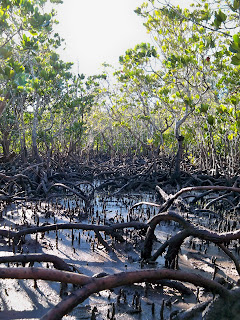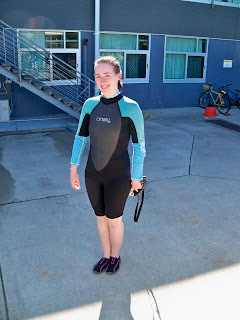Here I am, three months later, once again in a backpacker's hostel in the Brisbane Central Business District. I have turned in both of my final assignments - not perfect, but done. This trip started out very slowly, but the past several months have just flown by. This is the least stressful quarter I have ever had, despite the fact that my program was 21 quarter units. I snorkeled on the Great Barrier Reef for research, watched hundreds of hatching baby green turtles run to the water, woke to the sound of kookaburras calling, hiked below majestic tree ferns and up moss-covered ravines, waded through rushing creeks, hung out with kangaroos and wallabies, gazed up at massive Eucalyptus trees, viewed ancient and modern Aboriginal art, meandered past strangler figs and venomous snakes in the rainforest, slogged through chest-deep water to stake dead fish to the sand, saw dolphins surfing waves and humpback whales breaching, and learned about the amazing ecology all around me. And that was just for school! In my spare time, there was dancing (including teaching lindy hop), karaoke, mountain climbing, weekend trips to explore the Sunshine Coast and Byron Bay, comparisons of culture between the United States and Australia, time to relax with my homestay family or with friends, and so much more. Living in a foreign country on my own has been both exciting and challenging, and I am both very ready and very sad to return to my regularly scheduled life (after I tour around Australia for a while longer, of course). Overall, I am very grateful that I made the decision 2 years ago to stay in college an extra year, in order to fit studying abroad into my schedule.
Some Reflections, Recommendations & Life Lessons:
- Trust that things will work out
- Getting a few points below perfect on an assignment may not be the end of the world (*gulp*)
- Don't eat vegemite unless you really like salt
- Sometimes activities that involve getting cold, wet, sandy, muddy, or handling stinky dead things can be fantastic experiences
- Take the time to watch the sunset
- Don't touch it unless you know for sure that it can't kill you
- Don't let the talent of any good cooks go to waste
- Be aware of your surroundings. Several benefits: you're unlikely to get mugged, and you might spot something really cool like a koala in a tree.
- Dance at every good opportunity
- Learn new things every day
- Have conversations with people you don't know (just not the sketchy ones)
- Travel, even if you're just visiting a location close to home that you've never taken the time to see before
Sunset at N. Stradbroke Island
























